 news
newsWhat a super convention! The Orchid Society of Alberta brought everything to Edmonton for us from the Star Trek Deep Space Nine Space Station to an Ancient Minoan temple. We had lots of good food, good people and plenty of orchids! On behalf of the Canadian Orchid Congress I would like to thank the Orchid Society of Alberta for the fine job as hosts of our 1995 show and meeting.
The Orchid Society of Nova Scotia is the host of the next convention. The OSNS ran an early summer show as dry run for the 1996 COC Convention in Halifax. The public attendance was poor, it was a hot sunny beach-type weekend. The OSNS decided to reschedule the event. After contacting the AOS, they set a new date: October 19 and 20, 1996.
The Canadian Orchid Congress now has a presence to the World Wide Web of the InterNet. What is the World Wide Web you say? Some have compared the World Wide Web to the World's largest hard drive. Information on most of the major computers of the world are linked using a friendly interface. It easy to master the World Wide Web with a Windows or MacIntosh point and click software. Anyone from anywhere in the world can access information on many subjects including orchids. You can reach the Canadian Orchid Congress from an InterNet connection by going to the URL:
http://www.ccn.cs.dal.ca/Recreation/OrchidSNS/coc.html
Now anyone in COC with an InterNet connection can find information on the COC. We have listings of our upcoming shows, speaker tours, executive etc.
This is one way we can improve communications at the COC. It is of course only part of the solution.
We would like to list our societies and contracts on the WWW. What we would like to place the COC Directory there, which contains the names and addresses and telephone numbers of each society's executive. Then people with access to the WWW can see the directory. This will help members of COC clubs with InterNet access. Then the public can learn about and contact your society.
We have already had the public contact us and join local societies through our COC site. If you or anyone on your executive does not have their name, address and telephone number as printed in the COC directory up on the COC World Wide Web page please contact me.
There are also connections to a couple of Web sites for other societies including two of our own - the Orchid Society of Nova Scotia and the Central Ontario Orchid Society. We've posted information about what's hot at the COC including the upcoming COC Meetings, the 1996 AOS Trustees meeting in Vancouver and the Dendrobium seminar in Toronto. If any society would like me to put up a special event on the World Wide Web, send me the information. It would be easiest if on a PC disk or better yet, email me.
Speaking of upcoming events, at the COC meeting in Edmonton, we decided that it would be appropriate if the Vancouver Orchid Society co-ordinated the Canadian display at the World Orchid Congress this year in Brazil. If you would like to contribute to the display, contact Marjorie Disher of the Vancouver Orchid Society at #117 2303 Cranley Dr., White Rock, BC V4A 7V3.
Some people have been asking about our COC Lapel Pins. It's a circular black pin with the COC Lady Slipper emblem and our name in silver. You can get one by sending a check made out to the COC for $5.00 ($4.00 for the pin and $ 1.00 for shipping) to me.
The fall speaker tour will be starting very soon. Our speaker tour chair, Landis Stanlake of Winnipeg, has done a fine job arranging for Sergio Englert, of Riscel Orquideas of Brazil to come and speak to our societies. In the fall of 1996, we plan to have Brian Rittershausen, from Burnham Nurseries of England.
Hope you're all having a great winter.
Steve Saunders, President, Canadian Orchid Congress
Being an avid gardener, I cannot pass a garden centre without my Chevrolet automatically turning in. This being the case last weekend, I was browsing in the bulb section When I was reminded that we dwell in the "Riviera" of Canada. Mild winters, no snow, no fur coats, and the ability to grow orchids outdoors.
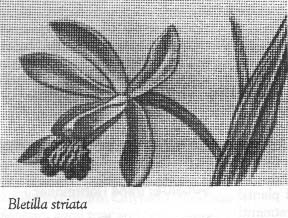
The orchid being carried by my local centre is Bletilla, or to give it its common name, the hyacinth orchid. Although Bletilla hyacinthina alba and Bletilla striata (as they are labelled at the centre) are the same species, the former being white and the latter pink, they are sold as two separate species and to save confusion I will do the same. Bletilla can be grown outdoors with minimal fuss both during the growing and winter seasons.
They require good drainage, some shelter from winter winds, can be in part or full shade although B. striata likes a little shade if possible. I plant them slightly deeper than the two inches recommended as the area I grow them in is slightly more open than I would like. The plants have bloomed for me repeatedly (but I can never resist buying another package, just in case!) without any winter protection. If you are concerned about overwintering in the ground, mulching with grass clippings at the end of summer should be all that is required.
Both orchids are well worth trying out as the display of blooms are quite attractive. They grow about a foot tall (metric defeats me unless it's in metres!) (30 cm) and you should plant several to give the maximum effect.
The alba form produces slightly more flowers per flower spike, but the striata form is more striking with a striped, frilly darker pink and white lip.
When the flowers finish I cut the spike down but leave the leaf until it naturally dies off. The corms will multiply each year. If you don't want to leave them in the ground over winter, grow them in a pot buried in the flower bed and lift them out at the end of the growing season.
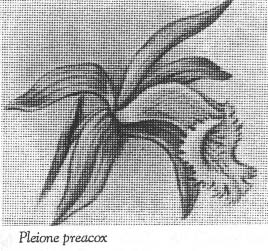
Another hardy orchid which is not as readily available to the novice grower is the genus Pleione. This orchid can be grown outside as well but is treated quite differently. The pseudobulbs are only set about 1/4 inch into the ground, the balance being above. They must be planted in an area where they will be protected from the rain both in the spring and in the winter. Under low branches of an evergreen tree, on the side of an inclined area would be perfect. They will not tolerate sitting in water and if water gets into the flower spike it will rot. This little beauty flowers first and then sends up one or two leaves during the summer as it forms new pseudobulbs as the old one dies.
The flowers of the Pleione are about 3 to 3.5 inches across and range in colour from white, pink, lavender, yellow and combinations of several of these colours due to breeding being done in England.
If they are left undisturbed, they will form large colonies. A native of China and Japan, they are well worth the extra care required to grow and flower them. Your local orchid society is probably your best bet for plants when members sell off divisions.
You will also find another orchid sometimes at your garden centre, one that is not hardy but sold with the packaged bulbs, Habenaria (radiata?). These are delicate little plants and must be taken in during the winter. I tried growing them outdoors but no luck. The small corms or tubers must be dried off after the foliage dies back, until the next spring.
Successful growing of Habenaria is best accomplished by growing in a small pot in fir bark (orchid bark). About the end of March I will bring out my pots and start to water them. The plants will grow and flower through the summer and die back in the fall. When the foliage has completely died back, I set the pots high up on the rafters of the greenhouse where they will receive no water at all until I decide to start them up again the next spring.
You can actually decide when you want them to flower by starting the watering earlier or later in the spring. As long as the potting medium has not broken down, I leave the Habenaria alone. With only actively watering the pot for half the year, the medium lasts four to five years before needing to be changed. The bark must be "seasoned" before you use it the first time, but would not need seasoning each year.
The Habenaria usually available from your garden centre is a beautiful white with a large fringed lip, about 1.5 to 2.0 inches across. A delight to grow. There are 500 different Habenaria species, some of which are native to North America, and as with all wild plants, they should be enjoyed in their native habitat and not uprooted. Plant propagation has allowed several of these lovely species to become available. I have pink, yellow and orange ones which I have obtained in my travels.
Look for these orchids in your local garden centre and give them a try. They are not big, but have a delightful, graceful flower and somehow when showing off your garden, snobbery sets in when you casually mention your orchids.
Marjorie Disher, Vancouver Orchid Society
Editors note: Even in the east Bletilla striate (hyacinth orchid) and Habenaria radiata (egret orchid) can be grown successfully outdoors but must be dug up in the fall and over-wintered indoors. They can be stored in dry peatmoss in a cool, dry position, even in the fridge!
When people were teasing my daughter Tessa about her size, she would reply "Good things come in little packages". But one day, a so called friend retorted, "So does rat poison!!" Well, you can imagine that they were no longer friends. I feel the same way when other people cannot understand my strange love for miniature orchids. I admit you have to take a second look or a magnifying glass to see the beauty of the blooms.
This report is in praise of the smallest orchid in my collection, easy to overlook but certainly deserving of mention: Lepanthopsis conception of Columbia.
It grows on a one inch square tree fern slab. It has many dark green oval shaped leaves about 1.5 cm long on a 2 cm stem. The flower spikes come out where the leaves join the stems. They are about 3 to 4 cm long and bear 10 to 18 flowers!!
A few years ago at the Victoria Orchid Society Show, I received a Certificate of Cultural Merit for this tiny plant. This award always goes to the grower but I do not deserve it; instead it belongs to that dainty little thing! There were 90 spikes in bloom and 6 in bud! I know this for sure because I cut them off one by one and counted them.
Let me tell you the truth, it grows and blooms all by itself. When I spray with the hose, it either gets hardly any water and so it seems to be dry constantly or it gets such a gush of water that it flies off and I have to hunt for it between the other orchid plants! The poor thing gets rough treatment! I did not even realize that it was in full bloom until a few days before the show. What a pleasant surprise!
I looked at the tiny blooms through my little light scope and could not believe how beautiful they are. On the spike, they are facing both sides, 8mm long and 2mm wide from petal to petal, have a round lip and a bright three lobed anther cap (I think that's what it is!!). The colour is cream, crystalline and shimmering with a pink blush. The lip has a round dark red spot. Believe me, these blooms are exquisite. How can nature make a flower so small, dainty and beautiful? just image how it gets pollinated and what a tiny seedpod it would be!
This little masterpiece of nature reminded me of old lace and this is the name I gave it: Lepanthopsis conception 'Old Lace' CCM/AOS
Irene Rohrmoser
Editors note: This article is printed as received, however, I had some dffficulty tracing the award. I eventually found the following in the Autumn, 1989 AQ: Lepanthopsis acuminata 'Old Lace', CCM (87 pts.) awarded to Irene Kothuber, Victoria Orchid Society Show, April 22, 1988.
The island of New Guinea is one of the largest islands of the world found completely in the tropics. The island has very high mountains so the climatic zones range from extreme hot and humid tropical at sea level to the cool cloud forests at high elevations in the mountains.
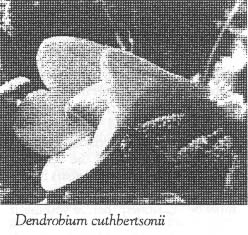
The species that has probably caught the eye of most orchidists is Dendrobium cuthbertsonii which comes in many delightful colour forms. These include red-orange, orange, lavender, white, cream and several different bicolor forms. Perhaps the most stunning is a white-green form with a red-brown edge to the lip. This is perhaps the most widely grown member of the Oxyglossum section of the genus Dendrobium.
Den. cuthbertsonii rarely grows more than two inches tall and usually forms mats on the trees and bushes in its natural habitat. The typical habitat for this species is in savannas like open meadows with stunted trees and scrubby bushes. Plants can be found on trees or bushes and even sometimes on the ground. In this habitat the plants are drenched with rain and mist during the night and dried out during the morning by the bright sunlight. There is always very good air movement.
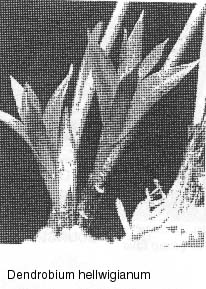
In cultivation Den. cuthbertsonii should be kept well misted with good air circulation and allowed to dry by nightfall. They should never completely dry out or they will lose their leaves.
Some other members of the Oxyglossum group are:
Based on a talk given by Larry Moskovitch to the Central Vancouver Island Orchid Society, October 1995
Members of the huge orchid family who make their home in the northern hemisphere are called perennial terrestrials. They are rooted in the soil which gives support and protection. They are well adapted to our climate and retreat below the ground in winter, to emerge again in the spring, to bloom, produce seed and die down again for their yearly rest. A prolonged cool rest is essential for their ability to bloom again, (3 to 4 months at 34F - 40F)
There are about 200 species of native orchids in North America. More than half are found in Florida, many of them immigrants from Mexico. Canada has far fewer species, but they are often very abundant. Some of our species are circumpolar, among them our slipper orchids, Calypso, rattlesnake plantain, coral root and Spiranthes.

I will only mention the slipper orchids today, because they are very showy. The members of the genus Cypripedium are scattered all over the northern hemisphere, (55 species). Most frequently found in Canada is the hairy slipper orchid, Cyp. calceolus v. pubescens. It has a large yellow pouch with brownish or greenish petals, sometimes twisted or flat. There is great variation in height, colour and form of this group, indicating hybridization and backcrossing within the group and with C. parviflorum (small flowered slipper). It is a daintier plant, with a deep golden labellum, twisted dark brownish petals often fragrant. C. passerinum, the sparrow's egg slipper, likes a cooler climate further north. I have seen it in Alberta always associated with Orchis rotundifolia (Amerorchis rotundifolia), our round leaved orchis. It grows also in the Yukon on Kluane Lake. The beautiful C. montanum, our mountain slipper with a large white pouch and brownish petals and sometimes with 2 flowers on a stalk can be found over most of B.C. I must mention 3 species which are more often found in Ontario, Manitoba and along the East coast but can be grown in B.C. First is C. reginae, the showy slipper and the queen of them all. It is a tall plant with large, light green, veined leaves and a pink pouch with white petals. It is a sun lover and so is C. candidum, which must be planted in full sun. It is a very rare plant for us and hard to come by. In this group falls C. acaule, the Moccasin flower, a very beautiful and desirable plant but the hardest of all to grow in captivity. I have seen large groups of it in Nova Scotia in full bloom which is a sight not to be forgotten. There are a few other species which are not often found or cultivated.
Orchids are well known for their willingness to hybridize and the natives are not different. C. x Andrewsii and C. x Favillianum represent crossings between the 2 yellow slippers with C. candidum. They have been known for over 100 years. The most recently discovered hybrid, C. x Columbianum again represents crosses between the 2 yellow slippers and C. montanum.
Most books tell us that Cypripediums cannot be grown in gardens or containers. I know that many people have grown them for many years. Some are grown in small artificial bogs, but not all need a bog to do well. Large wooden containers 12"xl2"xl2" with drainage holes are good, if a well draining mix consisting of peat, garden soil high in humus, sand and chicken grit is used. More acid lovers like the Moccasin flower should have pine needles added to the soil (pine duff). All Cypripediums need good light, morning sun is beneficial and high shade. Many take full sun and during their growing season should never dry out. In the fall, less water is needed and in winter, protection from constant rain is necessary. Evergreen branches on top of the resting plants makes a good cover. A real snow cover is, of course, the best way.
The often mentioned symbiosis with a beneficial fungus is important for seed germination and early development, but as soon as the seedling sends up its first leaves to make its own food, the fungus is no longer necessary.
It is no longer possible to receive foreign species for us to grow and I have had the fortune to try only C. japonicum and C. formsanum. They will live and grow here, but beware of unsuspected sudden frost.
Emmie Fisher
A plant for those who find delight in interesting or unusual plants and flowers as apposed to striking and gorgeous is a Porpax meirax (or P. elwesii R. Northern 1980). It is not as unusual as the Truffula Trees in Dr. Seuss's Lorax, but it has some interesting and unusual aspects that I would like to tell you about.
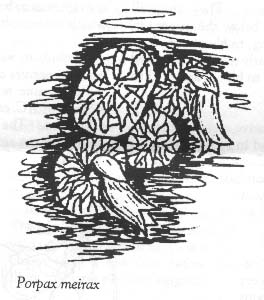
The plant is almost like a pattern of scales 0.6 to 1 centimetre across found on the smaller branches of trees and sometimes rocks in the Sikkim area of India. These flat pseudobulbs (4 mm) have a sheath that is net-veined giving them an interesting texture. The small bright green willow-like leaves are deciduous and turn red-brown and drop in the fall. It is about this time that some interesting birdhead-like buds appear from the center of some of the pseudobulbs. These extend and usually point downward until they are about one centimetre long. When opened they are tubes with flared open ends. The colour is a dull medium brown with the look of velvet.
The suggested culture is either in a mounded shallow pot to ensure excellent drainage or on a vertical slab. The plants are presently dropping their leaves and starting to flower so water must be now less and will finally stop altogether until the new growth cycle starts after Christmas some time. It is best to watch closely as water must be supplied when new growths first show or the plant will suffer greatly.
I will be lightly spraying my plants once a week or so as I do not want them to become dehydrated. In these dry months in northern India there is usually some morning dew, which evaporates quickly, to keep the plants from shrivelling. The plants should be sprayed freely when in growth and dipped in a weak fertilizer solution occasionally. Free air circulation is important also.
My plants are growing under lights and have done very well this summer. They are said to require temperatures on the warm side of intermediate but this is not too clear in the literature. They probably would like it a little cooler while dormant. According to one article they should not be moved around as they do not adjust well to facing a different direction and will eventually perish. This seems a little harsh but I presume there is some experience and truth behind the statement. These are charming little, or should I say, tiny plants and the flowers are delightful little things that require you to stop and carefully try to find them amidst the dying leaves.
Reference:
A.O.S. Bulletin December 1971 pp.1068-1072.
Indian Orchids (1979) U.D. Pradhan.
Miniature Orchids (1980) R. Northern.
Mike Miller
Mike is a school teacher and lives in Parksville, BC. He is the Newsletter Editor for the Central Vancouver Island 0.S. (He also imports Indian Orchids)